Menus
- Three two-stroke engines, one goal
- Benelli 250 2C weighs only 134 kilograms with a full tank
- First gear, foot three meters, engage
- Almost handier than a bike
- No brand antics with Maico
- Rough but honest – the Maico MD 250
- Modest effect of the Maico brakes
- Suzuki GT 250 in first hand for 40 years
- GT jumps off the line in an inclined position
- Data: Benelli 250 2C
- Data: Maico MD 250
- Data: Suzuki GT 250
- Engine technology
- Opinions

wolf
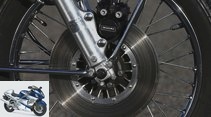
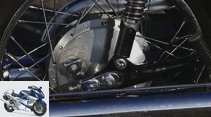
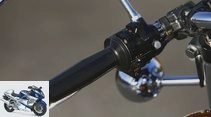
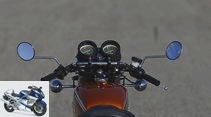
48 photos
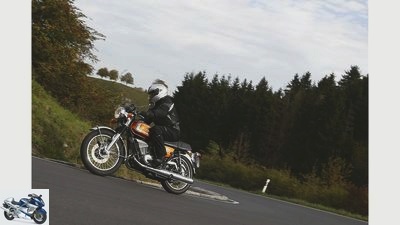
wolf
1/48
Suzuki GT 250.
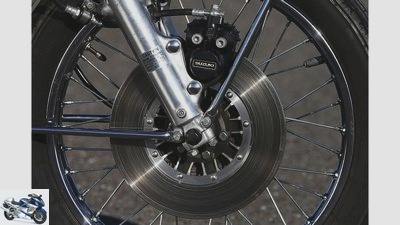
wolf
2/48
The once praised disc brake now looks a bit dull and toothless.

wolf
3/48
The brave 180mm rear drum brake saves the reputation of the GT 250 brakes.
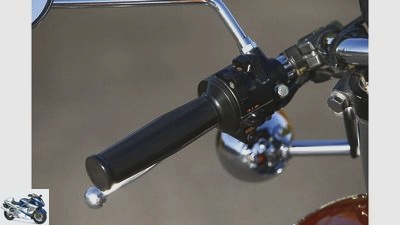
wolf
4/48
Suzuki GT 250.
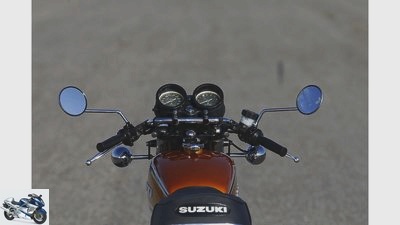
wolf
5/48
The easy-to-read instruments in the Suzuki cockpit are the Japanese standard.
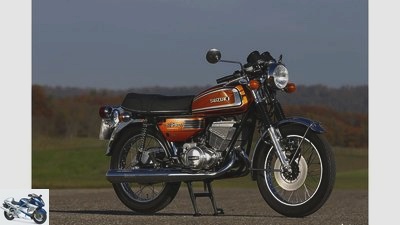
wolf
6/48
Suzuki GT 250.
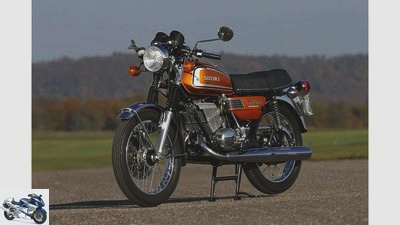
wolf
7/48
Suzuki GT 250.
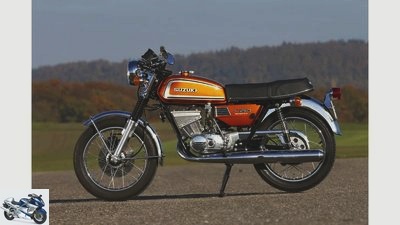
wolf
8/48
Suzuki GT 250.
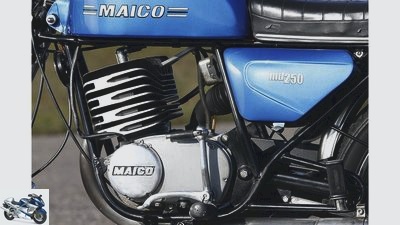
wolf
9/48
The short kick starter always requires a firm kick.
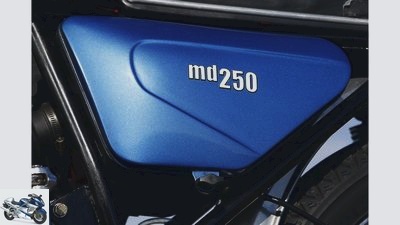
wolf
10/48
Maico MD 250.
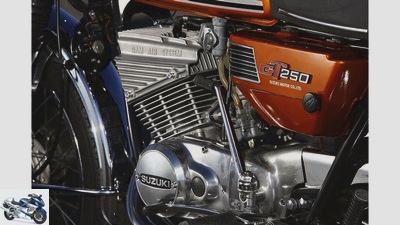
wolf
11/48
Idiosyncratic but effective: the Suzuki’s mighty Ram Air deflector.
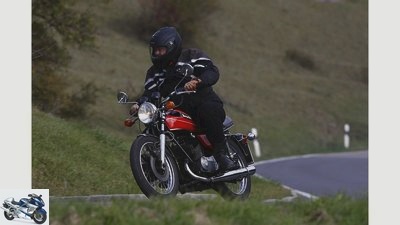
wolf
12/48
Benelli 250 2C.
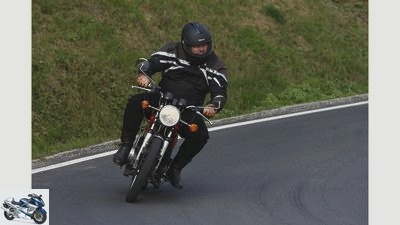
wolf
13/48
Benelli 250 2C.
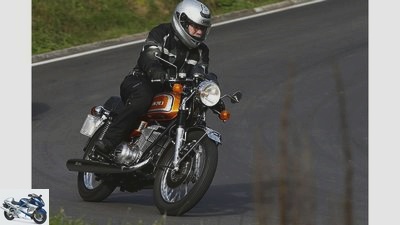
wolf
14/48
Suzuki GT 250.
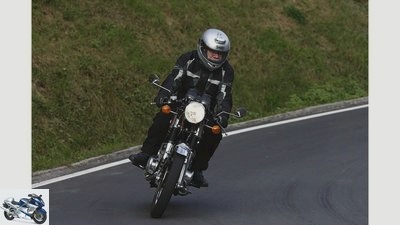
wolf
15/48
Suzuki GT 250.

wolf
16/48
Suzuki GT 250.
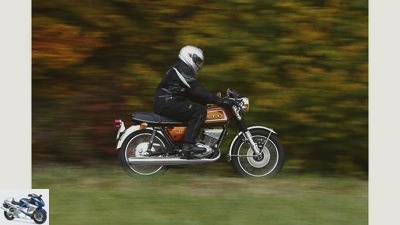
wolf
17/48
Suzuki GT 250.
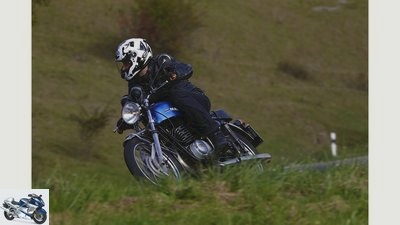
wolf
18/48
Maico MD 250.
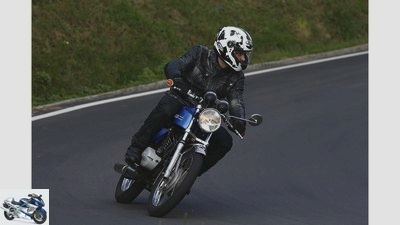
wolf
19/48
Maico MD 250.
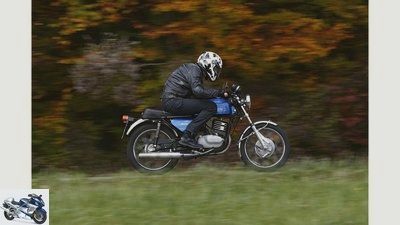
wolf
20/48
Maico MD 250.
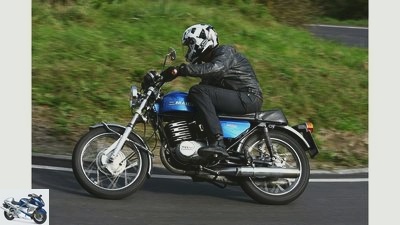
wolf
21/48
Maico MD 250.
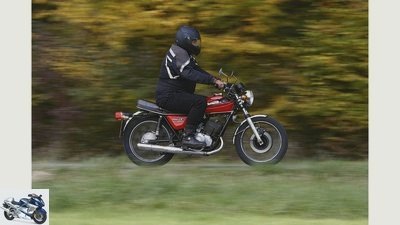
wolf
22/48
Benelli 250 2C.
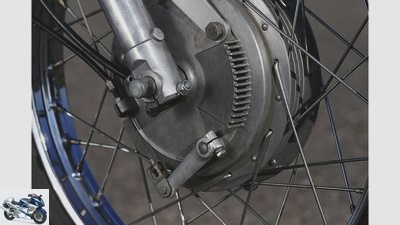
wolf
23/48
Rear weaknesses: drum brake and undersized axle.
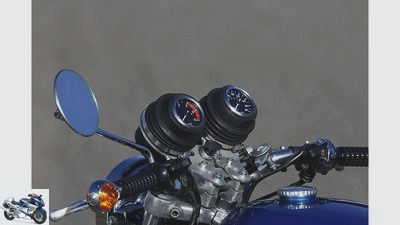
wolf
24/48
You can save yourself looking at the small, hard-to-read clocks.
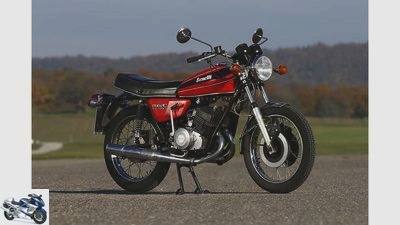
wolf
25/48
Benelli 250 2C.
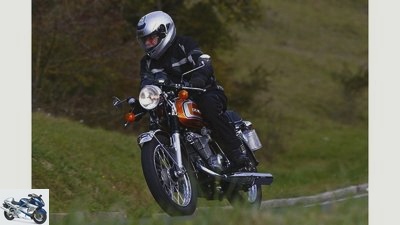
wolf
26/48
Suzuki GT 250.
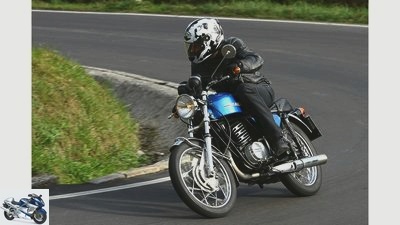
wolf
27/48
Maico MD 250.
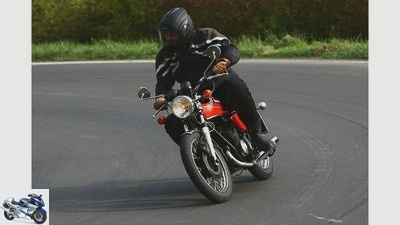
wolf
28/48
Benelli 250 2C.
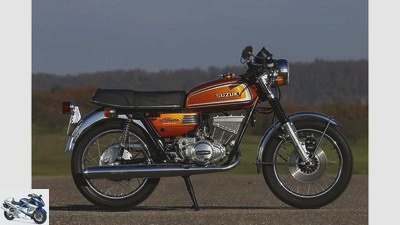
wolf
29/48
the Japanese Suzuki GT 250.
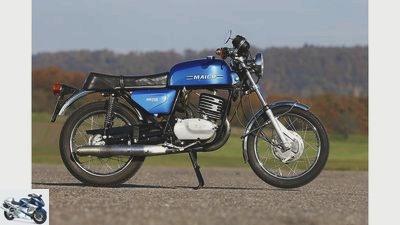
wolf
30/48
the Swabian Maico MD 250 and …
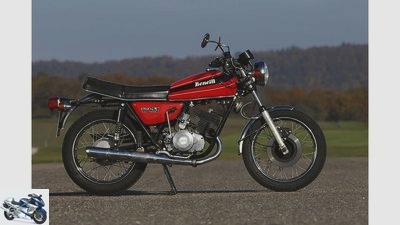
wolf
31/48
In comparison, we now turn to the Italian Benelli 250 2C, …
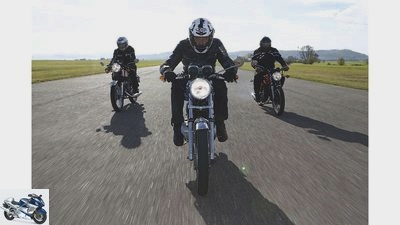
wolf
32/48
… or even over 40.

wolf
33/48
None of the three owners regret the purchase – whether it was only two years ago …
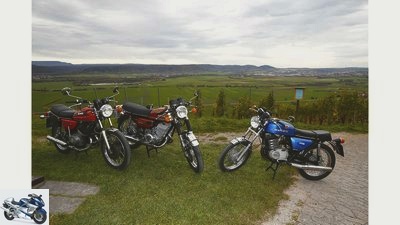
wolf
34/48
Sweet trinity: the three two-stroke engines.
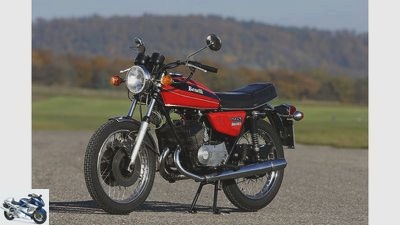
wolf
35/48
Benelli 250 2C.
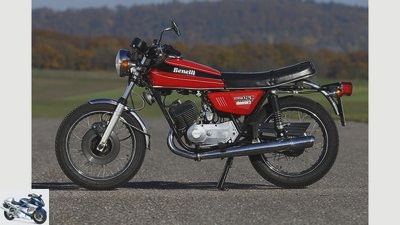
wolf
36/48
Benelli 250 2C.
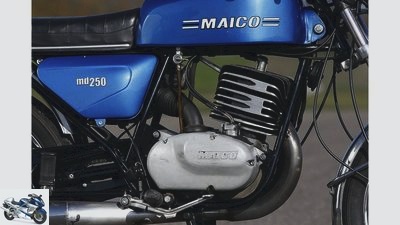
wolf
37/48
The idiosyncratic Maico single-cylinder proves to be a strong, rough leg.
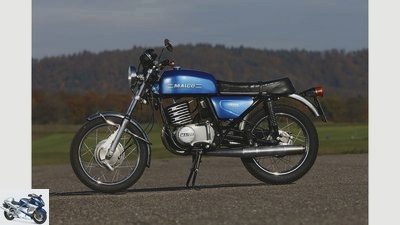
wolf
38/48
Maico MD 250.
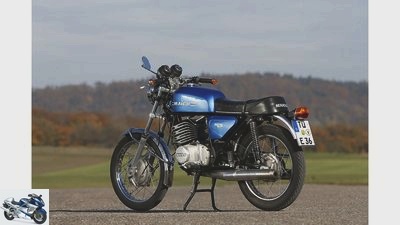
wolf
39/48
Maico MD 250.
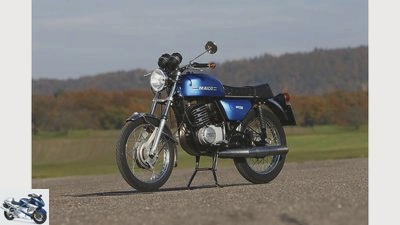
wolf
40/48
Maico MD 250.
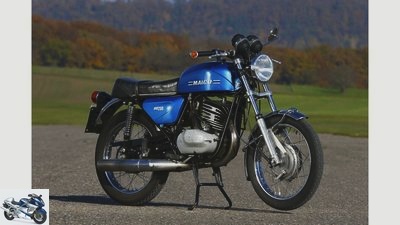
wolf
41/48
Maico MD 250.
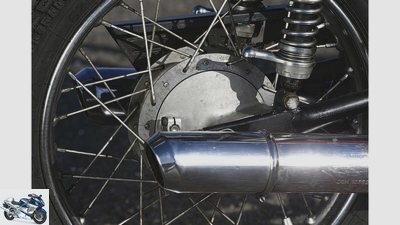
wolf
42/48
Benelli 250 2C.
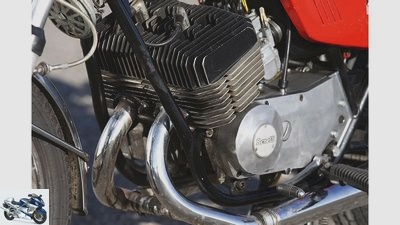
wolf
43/48
Benelli 250 2C.

wolf
44/48
The Benelli flatters with its classically beautiful cooling fin design.
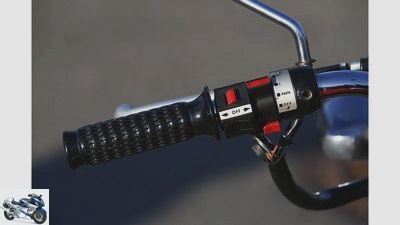
wolf
45/48
The playful switches can hardly be operated with thick gloves.
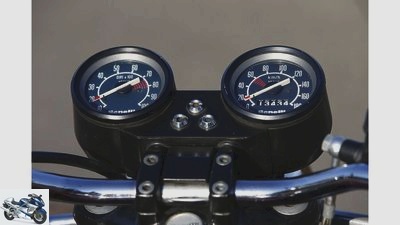
wolf
46/48
Faint little lights, you don’t have to take the red area too seriously.
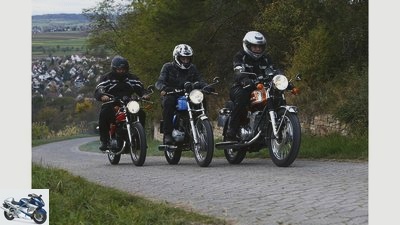
wolf
47/48
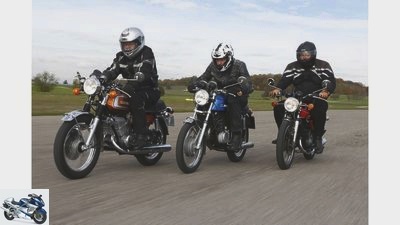
wolf
48/48
On the move with Benelli 250 2C, Maico MD 250 and Suzuki GT 250
Three two-stroke engines, one goal
Content of
There is agreement on one point: Nothing beats the crisp bite of a two-stroke engine. So we grabbed a Benelli 250 2C, a Maico MD 250 and a Suzuki GT 250 for a test drive.
D.u have to go out into the world, happiness does not ring at your door, is a wisdom preached by parents / grandparents. Wrong – because sometimes it does. Just like that Saturday afternoon in October. Actually, it doesn’t bode well if the doorbell rings and you don’t expect a visitor. Too often the Jehovah’s Witnesses are standing at the door or representatives who want to talk into useless stuff. This time it was different. “Hello Mr. Eirich,” I heard, “I hope I’m not bothering you, but I’ve already passed your Triumph several times, looking for one and just wanted to ask if you might want to sell it.” , I don’t want to, but after seeing the Guzzi Nuovo Falcone, with which the friendly prospect is on an afternoon jaunt, my skeptical reserve gives way and we start a conversation and exchange ideas about our vehicle fleet.
Buy complete article

On the move with Benelli 250 2C, Maico MD 250 and Suzuki GT 250
Three two-stroke engines, one goal
Benelli 250 2C. The small and light two-stroke engine that has long been on my wish list for a 250cc comparison. If that’s not a hint … Okay, the term “happiness” used at the beginning is perhaps a little over the top, let’s call it a happy coincidence, because Henzler lives in the next but one village, only a few kilometers away. Helmut Ziemer, owner of the Suzuki GT 250 he was looking for, also lives in the immediate vicinity. Sometimes the world is just very small.
Benelli 250 2C weighs only 134 kilograms with a full tank
The Benelli 250 2C is also small and, above all, delicate, as it ultimately stands in front of me on a cool autumn day. No wonder, since it was developed in parallel with the 125 and is almost identical in all parts. The motor housing is used by both machines, but the 250 light metal instead of gray cast iron cylinders with hard chrome-plated raceways were used. This reduced the weight of the engine by a whopping ten kilograms. So it is ultimately not surprising that the Benelli 250 2C has become as light (and also drives) as it looks. Only 134 kilograms with a full tank are a word. The alleged 24 hp are, completely atypical for Italians, quite low. The slot-controlled engine with the unusual displacement of only 232 cm³ leaves doubts in view of the driving performance. In MOTORRAD measured 150 km / h lying down and a remarkable 140 sitting as well as an acceleration in 7.4 seconds from zero to 100 km / h indicate significantly more power. Italo specialist Norbert Brauninger knows from his own 34 PS of the 250 2C, measured on the roll, what fits better.
First gear, foot three meters, engage
Pure numbers games that owner Boris Henzler doesn’t care about. He also owns other bikes and only uses the Benelli 250 2C for occasional after-work jaunts without any sporting ambitions. First of all, the fragile plastic flaps on the carburetor have to be operated to aid cold starting. “Be careful, they break off easily,” warns Henzler. No problem. On the second step, the beautiful, finely ribbed two-stroke engine comes to life and sounds self-confident even when standing still. The Benelli makes acoustically on Adriano Celentano with a hearty, bassy two-stroke tune. Should we afterwards pour liters of grappa into the small tank instead of super? Not to forget the two-stroke oil to be mixed in.
So go ahead now. You sit low on the slim Benelli 250 2C, dainty like the proverbial bike, it appears to be stationary and in motion, after you have carefully measured the somewhat stiff clutch when starting and the Italian starts moving with little gas. Yes, it works without astronomical speeds, no, there is no cool propulsion for it. It quickly becomes clear that real acceleration only sets in from 5500 to 6000 tours. In the narrow area at the very top, however, the Benelli flares a first-class two-stroke fireworks display. Fortunately, by the way, with a silky smooth run and almost no vibrations. It may be that our model is not optimally adjusted / sprayed, especially since it calls for choke support for a long time and simply goes out even when it is warm. No problem: first gear, foot three meters, engage – runs again.
Almost handier than a bike
The Italian puts the driving pleasure on the undulating, curvy side streets in the well-known light: handiness and chassis are top notch. The spring elements from Marzocchi do a good job, a pleasant compromise between firmness and swallowing capacity. The Benelli 250 2C gives in almost exuberantly and willingly, the more touristy, relaxed seating position on the low bench in connection with the notches placed quite far forward and the high handlebars could be a bit sportier. The shift travel of the five-speed gearbox is long, but if you operate it carefully, the gears lock exactly into place. After all, the Benelli 250 2C, a 1977 model, has long had the normal gearshift pattern, the first examples still offered the reverse gearshift pattern, with first gear at the top.
In any case, the Benelli 250 2C is not for lazy shifters – even the first slight incline forces you to shift down to fourth, at speeds below 5500 rpm you starve to death here. If you want to slow down the pace intentionally and abruptly, you have the best cards. In contrast to the first years of construction with the double simplex drum brake, the Italian had a disc brake in the front wheel from 1976 onwards. At that time, the Brembo system could even be converted to a double disk using an accessory retrofit kit (e.g. from Demharter), as is installed on Henzler’s copy. It is hardly surprising that the system has an easy job with the 250. The bite and braking effect leave nothing to be desired, the quality of fittings and switches and the workmanship are more likely. But the Benelli exudes the irresistible charm that around 6000 buyers once succumbed to. As a child of the de Tomaso group, the 250 was also offered with a different paintwork as the Moto Guzzi 250 TS and under the company name Motobi, and 320 copies were even sold as the Hispano.
No brand antics with Maico
The men at Maico didn’t go along with such brand antics. In the Swabian town of Pfaffingen, things were more pragmatic than playful. Design was less in demand, technology and performance counted. Honest, down-to-earth, that’s how a Maico has always been. And quick, the Swabians had earned this reputation early on in off-road and motocross racing. But even the development of a “middle class” road machine with 250 cm³ ran into difficulties: On the one hand, the economy of the Swabian company bosses, and on the other hand, the resulting orientation towards the 125cc as a basis. This ultimately also led to the ultra-short-stroke design of the 245 cm³ single cylinder with its 54 mm stroke and a powerful 76 mm bore. The prototype was shown at the Milan Salon in 1971, but the Maico MD 250 did not go into series production until the beginning of 1974.
Rough but honest – the Maico MD 250
The copy we drove found its way late, namely in 2000, to its current owner, Harald Muske. And that, when the 53-year-old Swabian lives almost around the corner from the former Maico factory and has known some of the old Maico makers since childhood. Still, his first bike back then was a Hercules. Today he is an enthusiastic Maico driver and also the owner of an MD 50 and MD 250 WK. Honest and direct – that applies to Maicos and their owners. Muske puts it in a nutshell when the vehicle is handed over: “When you start, you really have to let it go. The maico wants to be kicked and turned. And she can handle it. ”Everything is correct, especially the approach. However, if you forget to close the fuel tap when you stop, the 32 Bing carburettor tends to drown and forces you to start sliding and then fogging the environment. Incidentally, the carburetor is well hidden under the right housing cover, directly in front of the rotary plate valve that controls the inlet, and shares the space under the cover with the automatic gearshift of the draw-key six-speed gearbox.
The sporty ambitions are evident in the choice of the valve timing and the design and number of flushing channels in the cylinder. The officially mentioned 28 HP always seemed an understatement, even in the early stages there was talk of a measured 32 HP on the crankshaft. Maico owner Muske also expresses his doubts here: “She walks like a pig, certainly has over 30 real horsepower.” Let’s see. The Maico MD 250 runs, initially wants to be kept alive with throttle blows and blares powerfully into the group even before the journey. Take a seat, quite far in front and close to the handlebars, put your feet on the notches that are also far in front and enjoy the rustic driving pleasure. Even at low speeds, the Maico pushes powerfully, no trace of high performance characteristics. Although the speed can only be estimated because the tachometer in the barren, already difficult to read cockpit refuses to work, the performance can already be called up cleanly in the lower third. Without a brute kick, the Maico delivers powerfully across the entire belt and calls me again Reminder readings from previous tests. 6.6 seconds to 100 km / h, 159 things top – these values still sound credible today. The lightweight construction has also paid off here, only 126 kilos plus driver can easily be accelerated.
Modest effect of the Maico brakes
Easy, yes, not quiet. And certainly not without vibrations. From around two thirds of the available band, which goes up to over 8000 rpm, where the engine then closes, an angry roaring soundscape and vibrations set in, which make the hands tingle after just a few kilometers. The typical Maico howling and whistling of the rotary valve motors does not sound on the 250. It can’t, because the intermediate gear of the primary drive via spur gears that is responsible for this is missing here. Instead, the Maico MD 250 uses a duplex chain. Acceleration and sound are breathtaking, the switchability of the often scolded draw-wedge gear means that there are no complaints here. Avid stirring in it is just as fun as the astonishing handling of the light MD 250. The short wheelbase of only 1330 millimeters does the rest, and because the sturdy chassis with the solid double loop frame made of 22 mm tubes also works, the Maico can be moved over without wobbling drive the highway. Of course, the well-coordinated 32 mm Marzocchi fork and the tightly dampened and cleanly appealing Girling struts at the rear also help.
The performance of the Italian-made double simplex drum brake from Grimeca can only be described as poor. How great could you be heating over the country if you weren’t afraid of every bend, given the high level of hand strength, the moderate dosability and the even more modest effect of the stoppers? The fact that components from German production are not covered with fame (the VDO instruments were always imprecise, difficult to read and not leakproof, therefore mocked as “water clocks”) is hardly consoling. But that was probably not the reason that only exactly 1,327 machines were built by 1977, most recently sold at the new price of 4,069 marks. It’s good that this specimen survived.
Suzuki GT 250 in first hand for 40 years
There was never any question that Helmut Ziemer’s Suzuki GT 250 would survive. He finally bought the L-model, built in 1974, that same year and is therefore still the first owner after more than 40 years. Of course, the GT has already had an exciting life and meanwhile an engine overhaul by the specialist Reimo behind it, but otherwise the machine is almost in its original condition. Apart from minor cosmetic repairs such as the seat. Unlike the Maico MD 250, Suzuki had a 250cc life before the GT. As early as 1967 the Japanese caused a sensation with the T 20, and with the introduction of the T 250 the well-deserved sales success set in. The GT 250 K (L for 1974, M for 1975) offered in Europe from 1973 onwards amazed with the eye-catching Ram Air system, which was supposed to provide better cooling on the cylinder head and was only abolished when it was replaced by the GT 250 A in 1976.
In Japan, too, the performance information was rather low – at least the information in the German vehicle registration document only showed 25.5 hp. Which seems only partially believable. After all, the old test values from MOTORRAD document a respectable 7.6 seconds for the sprint to 100 km / h and a respectable top of 154 km / h (lying). The Suzuki GT 250 turns out to be the smoothest, most unspectacular 250 in comparison. Even the start works without grumbling on the second step, starting is possible with a low speed (2500 tours are always enough) and without excessive abuse of the smooth clutch, the choke can be deactivated after a few hundred meters. The mounted Magura clip-on handlebars can be considered a contemporary accessory, forcing the driver into a crouched, sporty, gathered posture on the compact GT. The tank even allows a more comfortable knee grip than on the ultra-slim Benelli. Everything works smoothly and reliably, the switches are easy to operate, the instruments are easy to read – Japanese perfection. The performance characteristics also reflect the character of the Suzuki – polite and gentle, but still with the desired two-stroke bite, which starts from around 5500 to 6000 rpm, although not as blatantly as with the quick-tempered Benelli or the boyish Maico. It goes without saying that this tendency also continues with the sound. The GT engine sounds more discreetly sawing, with a light tone. He never becomes a screamer, vibrations are very subtle and only noticeable in the range of 4500 to 5000 rpm. At speeds above 7000 rpm, the two-cylinder still looks a bit tough, and after its overhaul it will have to retract and retract properly, says Ziemer.
GT jumps off the line in an inclined position
The great handling of the nimble Suzi has always been flawless, which is still terrific even today on tight changing bends. With increasing speed, the Suzuki GT 250 becomes a little stiffer, more stubborn, does not wag around fast corners as easily as the Benelli 250 2C, but remains super stable in every situation as long as the road is level. If potholes or bumps come into play, both the fork and the shock absorber are a bit stubborn in response and tight in their coordination, and the GT can easily jump off the line when tilted. However, this hardly reduces the driving pleasure, especially since the easy change of levels in the precisely shiftable six-speed gearbox is a real pleasure. The 15-liter tank, in conjunction with the moderate consumption of 5.5 to 6.5 liters / 100 kilometers (Benelli never less than seven liters), enables decent ranges. When refueling, you don’t have to worry about adding the right amount of oil, thanks to the patented CCI lubrication system, fuel is carefree and the oil tank is only refilled every now and then.
Today there is no long distance and no motorway bolt, but “only” wonderful cornering on the country road, and fortunately I wished the Japanese brakes a little bit more snappy, less bluntly appealing. The rest fits, and I can understand the 62-year-old owner that he has been loyal to the Suzuki GT 250 for over 40 years. Especially when the paintwork in Candy Tahiti Orange shines in the evening light … For today I am giving the GT back, but in Boris’s garage there are other Suzuki sweets waiting to be recognized in a story in addition to the 250 . By the way: Boris is welcome to ring my doorbell in the future, even if it is to suggest a trip with the Triumphs. In the meantime he has found and bought one.
Data: Benelli 250 2C
wolf
Benelli 250 2C.
Engine: Air-cooled two-cylinder two-stroke engine, slot-controlled with reverse flushing, bore x stroke 56 x 47 mm, compression 10.3: 1, displacement 232 cm³, output 24 HP at 7500 rpm, two Dellorto carburettors, Ø 22 mm, mixed lubrication 1:25
Power transmission: Multi-disc clutch in an oil bath, five-speed gearbox, chain drive
Landing gear: Double loop tubular frame, hydraulically damped Marzocchi telescopic fork at the front, stanchion diameter 32 mm, two Marzocchi struts at the rear, wire-spoke wheels with steel rims, tires at the front 3.00 S 18, rear 3.25 S 18, Brembo disc brakes at the front, Grimeca Simplex drum brakes at the rear, Ø 158 mm
Mass and weight: Wheelbase 1310 mm, weight with a full tank 134 kg, tank capacity 12.5 l
Mileage: Top speed 150 km / h
New price (1976): 3849 marks
Data: Maico MD 250
wolf
The short kick starter always requires a firm kick.
Engine: Air-cooled single-cylinder two-stroke engine, inlet controlled by a rotary plate valve, bore x stroke 76 x 54 mm, compression 11.7: 1, displacement 245 cm³, output 28 HP at 7000 / min, a Bing slide carburetor, Ø 32 mm, mixed lubrication 1:50
Power transmission: Four-disc clutch in an oil bath, six-speed gearbox, chain drive
Landing gear: Double loop tubular frame, hydraulically damped Marzocchi telescopic fork at the front, stanchion diameter 32 mm, two Girling struts at the rear, wire-spoke wheels with steel rims, tires front 2.75-18, rear 3.25-18, Grimeca double simplex drum brake front, Ø 180 mm, simplex – rear drum brake
Mass and weight: Wheelbase 1330 mm, weight with a full tank of 126 kg, tank capacity 12.5 l
Mileage: Top speed 159 km / h
New price (1974): 3,645 marks
Data: Suzuki GT 250
wolf
Idiosyncratic but effective: the Suzuki’s mighty Ram Air deflector.
Engine: Air-cooled two-cylinder two-stroke engine, slot-controlled with reverse flushing, bore x stroke 54 x 54 mm, compression 7.5: 1, displacement 247 cm³, output 25.5 HP at 7000 / min, two Mikuni slide carburettors, Ø 26 mm, CCI separate lubrication
Power transmission: Multi-disc clutch in an oil bath, six-speed gearbox, chain drive
Landing gear: Double-loop tubular frame, hydraulically damped telescopic fork at the front, stanchion diameter 33 mm, wire-spoke wheels with steel rims, front tires 3.50 S 18, rear 3.25 S 18, hydraulically operated disc brake with two-piston floating caliper at the front, Ø 280 mm, simplex drum brake at the rear, Ø 180 mm
Mass and weight: Wheelbase 1310 mm, weight with a full tank of 155 kg, tank capacity 15 l
Mileage: Top speed 154 km / h
New price (1975): 3725 marks
Engine technology
wolf
The Benelli engine with the finely ribbed cylinders is supplied by two 22-millimeter square slide central float carburetors from Dellorto. The exhaust gases leave the two exhaust pipes with a robust sound.
The hotly contested 250cc “middle class” got more and more growth in the 1970s. Benelli did not want to stand back here either and sent two very compact two-cylinder (125/250) with identical engine housings into the field. Initially designed with cast iron cylinders, the engine for the 250 series developed by the German engine designer Peter Durr was fitted with aluminum cylinders and a hard chrome-plated raceway, which saved more than ten kilos in weight. In retrospect, why the two-cylinder with a 56 mm bore and 47 mm stroke, which is quite short-stroke and only 232 cm³, does not utilize the full displacement measure for a 250, is often explained with the lapidary reference to a luxury tax on more displacement. What is certain, however, is that the engine with its fine and effective cooling fins always delivered more than the specified 24 hp, usually just over 30 hp. The two-cylinder, equipped with a four-way bearing crankshaft and modern ingredients such as contactless electronic ignition, amazes with its silky smooth, almost vibration-free run. Weak points, such as the shift claws that were initially made of bronze and often break, were fixed and the parts were soon made of steel. The vulnerable and weak 6-volt system remained, but can be converted to 12 volts using an accessory conversion kit (for example from www.powerdynamo.biz).
wolf
Strikingly ribbed fan cylinder of the Maico MD 250. This trick should help against the buzzing. Unfortunately, it does not protect against rough vibrations.
The German competitor Maico did not save on ignition and opted for a contactless thyristor ignition from Krober. Overall, however, the red pencil often reigned in the development of the single cylinder. The 125cc had to serve as the basis, which ultimately led to the extremely short-stroke design (bore x stroke: 76 x 54 mm). The piston of the 250 came from Mahle, where the Nikasil coating of the cylinder took place. The racing-like control times of the rotary valve (223 crankshaft degrees opening angle) are also extreme. Directly in front of it sits the 32 mm slide carburetor from Bing under the right housing cover, under which the automatic gearshift for the draw-key six-speed gearbox is hidden. The single-cylinder, powerfully gripping in every speed range, with the triple-bearing crankshaft and needle-bearing connecting rod vibrates enormously in the upper range, but also usually produces well over 30 hp, although the factory only states 28.
wolf
Many people only know the Ram Air system in connection with an increase in performance through dynamic pressure ventilation of the engine. Here it only serves to cool the engine.
Suzuki also understates clearly with the power specification of 25.5 PS. The square (bore x stroke: 54 x 54 mm) designed with 7.5: 1 (Benelli: 10.3: 1, Maico: 11.7: 1) relatively low-compression two-cylinder, which does its gas exchange via slot control with reverse scavenging , in truth usually delivers a few more horsepower. Special features of the GT engine are not only the Ram Air system, a very effective air baffle for better cooling air supply to the cylinder head, but also the CCI lubrication system, which stands for Cylinder and Crankshaft Injection. The oil, stored under the left side cover in a 1.1 liter tank, is pumped by the oil pump not only to the inlet ducts, but also to the crankshaft, depending on the load (using the throttle grip) and speed (the pump frequency depends on the crankshaft speed) Main bearings and the connecting rod bearings. This solution contributes to a longer service life, lower oil consumption and reduced smoke development.
Opinions
wolf
Boris Henzler, owner of the Benelli 250 2C:
"The rare Benelli has fascinated me for a long time and has been inspiring me since buying it in 2013 and after some necessary work / modifications with its timelessly elegant design and its unbridled two-stroke sound. There are other motorcycles in my garage for everyday use, including Italian (four-stroke), but it still had to be a real barrel organ like the 250. She is seldom moved on after-work jaunts or on weekends, but then, with her biting character, it is a lot of fun – and although she drinks like a hole."
Harald Muske, owner of the Maico MD 250:
"14 years ago I decided to buy the air-cooled 250cc and never looked back. Although I first had to paint over the horrible yellow paintwork of the previous owner with the original blue mixed according to the template, there was almost nothing technically to be done. The (so often) defective second gear was done quickly, since then I have been using the MD 250 without any problems in everyday life, on the way to customers or just for fun on the home route. She is not treated squeamishly, but needs it exactly and is still going like hell."
Helmut Ziemer, owner of the Suzuki GT 250:
"I’ve been driving my first motorcycle, the GT 250, since 1974. What I find incomparable are its great sound, timelessly beautiful appearance and nowadays the rarity that inspire me again and again. It took some screwing in the last 40 years, but evenings in the garage have welded us together. I don’t want to miss them, even if a newer everyday motorcycle and other Suzuki two-stroke engines have now joined them: A rarely used, rare GP 125 (for my wife) and a GT 550 that I still have to get ready to drive."
Related articles
-
Hercules W 2000, Norton Classic, Suzuki RE5, Van Veen OCR 1000
wolf 47 photos wolf 1/47 The mighty radiator for the 4.5 liters of coolant shapes the front, but keeps the temperature balance in order. wolf 2/47 Brembo…
-
Test naked bikes Aprilia, Benelli, Ducati, Kawasaki, KTM, Suzuki and Yamaha
Naked bikes from Aprilia, Benelli, Ducati, Kawasaki, KTM, Suzuki and Yamaha Seven naked bikes in a comparison test Content of Naked bikes…
-
Suzuki V-Strom 1000 in the top test
fact 26th photos fact 1/26 First of all, the meticulousness with which Suzuki’s technicians and engineers went to work is surprising. The new V-Strom,…
-
fact Top test Suzuki GSR 600 Express yourself Standing out is more popular than ever today. And no longer reserved only for the large, prestigious…
-
On the move with Suzuki RV 50, RV 75, RV 90, RV 125
wolf 22nd photos wolf 1/22 With new tire sizes 130 / 80-18 at the front and 180 / 80-14 at the rear, the VanVan drives more precisely. wolf 2/22 The RV…
-
Jahn Comparison test Powercruiser Kawasaki VN 2000, Suzuki Intruder M 1800 R, Yamaha XV 1900 Midnight Star Punchtime Nobody distributes more displacement…
-
Comparison test: Honda CX 500-650 Turbo, Kawasaki Z 750 Turbo, Suzuki XN 85, Yamaha XJ 650 Turbo
Jahn 21st photos Jahn 1/21 The preload of the central spring strut of the Suzuki can be easily adjusted. Jahn 2/21 Thanks to the 16-inch front wheel, the…
-
Comparison test Honda CB 1300 S, Suzuki Bandit 1200 S, Yamaha FZ1 Fazer
Bilski Comparison test Honda CB 1300 S, Suzuki Bandit 1200 S, Yamaha FZ1 Fazer Search for clues They share their sporting roots. At Honda in terms of…
-
Johann Test Suzuki Bandit 650 ABS Bandit reissue An institution like the Suzuki Bandit 650 cannot be written off from a recently launched Yamaha XJ6….
-
Suzuki GSX-R 1000 R in the driving report
Suzuki 27 photos Suzuki 1/27 Suzuki GSX-R 1000 R. Suzuki 2/27 Suzuki GSX-R 1000 R. Suzuki 3/27 Suzuki GSX-R 1000 R Suzuki 4/27 Suzuki GSX-R 1000 R….